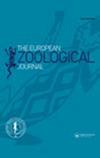Field estimates of detectability and site occupancy show that northern Italy forest molluscs are spatially rare and poorly detectable
引用次数: 10
Abstract
Abstract Estimations of site occupancy of species and their vital rates, and of species richness of a community, are biased if detection probability is not taken into account. Models that allow the joint estimation of occupancy and detectability were used in a land mollusc survey in six forest habitats in northern Italy, allowing estimations for 55 species of land snails. Most species were poorly detectable (p ≤ 0.3). Detectability varied among habitats and collecting techniques. Taking into account detectability, occupancy estimations may be from 15 to 85% larger than the naïve occupancy values computed by dividing the number of stations at which the species was detected by the total number of stations (0.13–0.42 in absolute terms), significantly altering our understanding of species rarity. In several habitats the share of spatially rare species was remarkably high, above 30%, with peaks above 60%; at the regional scale 62.7% for visual sampling and 46.7% for leaf litter and soil sampling. The sampling effort to monitor occupancy for the numerous uncommon to rare species is well above what would be satisfactory in terms of saturation of species inventory. Visual search gave higher estimates of detectability for species above 1 cm in size, while leaf litter and soil sorting gave higher estimates for species below 1 cm. Consideration of fresh empty shells along with living individuals allowed us to improve the estimates, but when interpreting results the bias induced by taphonomic processes has to be considered. When detection probabilities are unknown, an estimate of their order of magnitude may be obtained by relative abundances, while shell size does not correlate significantly with detectability.可探测性和场地占用的实地估计表明,意大利北部森林软体动物在空间上是罕见的,很难探测到
摘要在不考虑探测概率的情况下,对物种的立地占用率及其生命率和物种丰富度的估计是有偏差的。在意大利北部六个森林栖息地的陆地软体动物调查中,使用了允许占用率和可探测性联合估计的模型,对55种陆地蜗牛进行了估计。大多数种的检出率较低(p≤0.3)。在不同的生境和采集技术中,检出率各不相同。考虑到可检测性,占用估计值可能比naïve占用值大15%至85%,该占用值是通过将检测到物种的站点数除以站点总数(绝对值为0.13-0.42)计算得到的,这显著改变了我们对物种稀有度的理解。在一些生境中,空间稀有物种的比例非常高,达到30%以上,最高达到60%以上;在区域尺度上,目视取样占62.7%,凋落叶和土壤取样占46.7%。监测大量不常见和稀有物种占用情况的抽样努力远远超过物种库存饱和的令人满意的程度。视觉搜索对大于1cm的物种的可探测性有较高的估计,而落叶和土壤分选对小于1cm的物种的可探测性有较高的估计。考虑新鲜的空壳和活着的个体使我们能够改进估计,但是在解释结果时必须考虑由埋藏过程引起的偏差。当探测概率未知时,可以通过相对丰度来估计它们的数量级,而壳的大小与可探测性没有显著的相关性。
本文章由计算机程序翻译,如有差异,请以英文原文为准。
求助全文
约1分钟内获得全文
求助全文

 求助内容:
求助内容: 应助结果提醒方式:
应助结果提醒方式:


